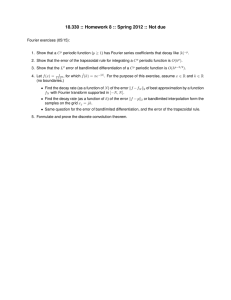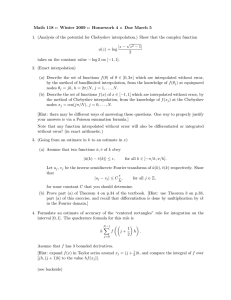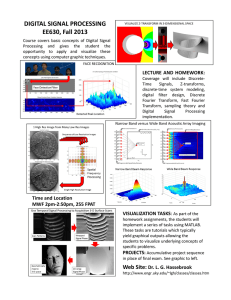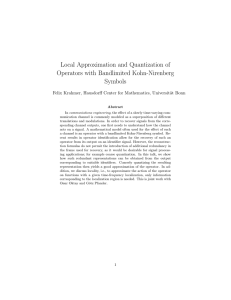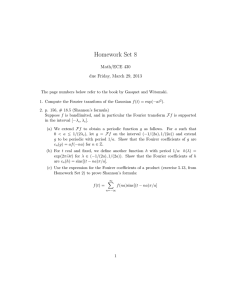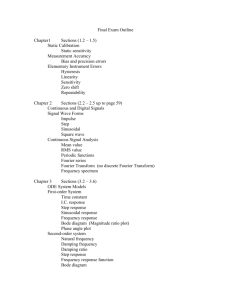On Bandlimited Signals with Minimal SpaceRime-B andwidth Product
advertisement
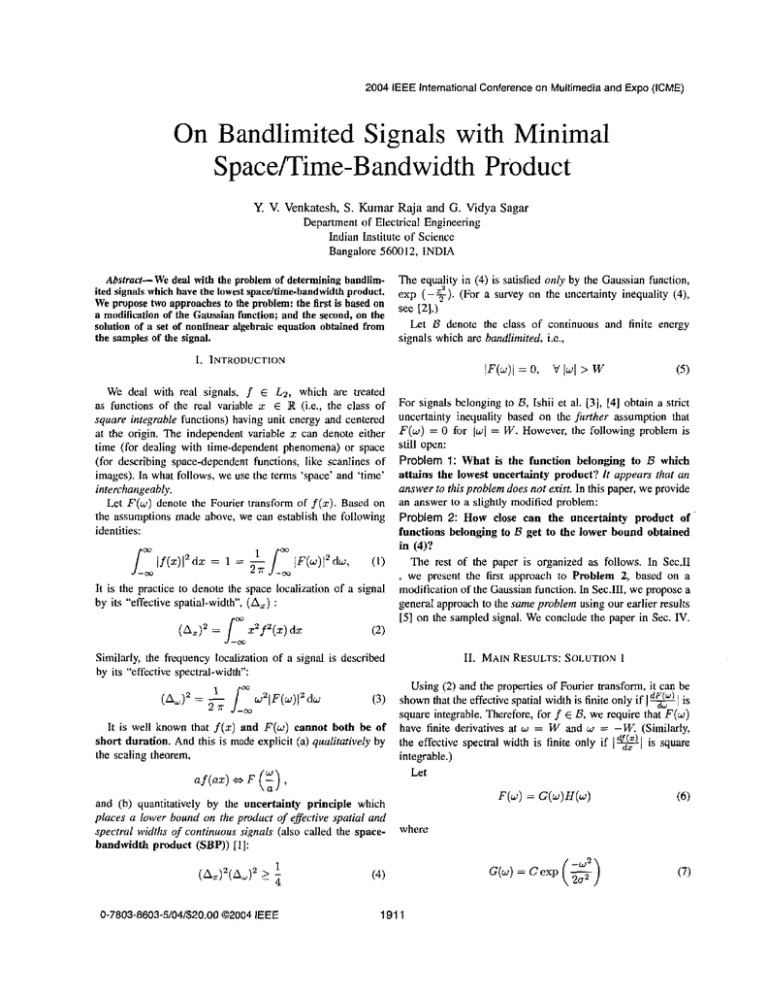
2004 IEEE International Conference on Multimedia and Expo (ICME)
On Bandlimited Signals with Minimal
SpaceRime-Bandwidth Product
Y. V. Venkatesh, S . Kumar R a j a and G. Vidya Sagar
Department of Electrical Engineering
Indian Institute of Science
Bangalore 560012, INDIA
Abstract- We deal with the pmhlem of determining handlimited signals which have the lowest spacdtime-bandwidth product.
We Dmuose two aDDroaches to the urohlem: the first is based on
The equality in (4) is satisfied only by the Gaussian function,
exp (-$). ( F a~ survey
~
on the uncefiainty inequality (4),
the samples of the signal.
signals which are bandlimired, i.e.,
---
rl
,
I. INTRODUCTION
lF(w)l = 0,
We deal with real signals, f E L z , which are treated
as functions of the real variable 2 E R (i.e., the class of
square integrable functions) having unit energy and centered
at the origin. The independent variable z can denote either
time (for dealing with time-dependent phenomena) or space
(for describing space-dependent functions, like scanlines of
images). In what follows, we use the terms ‘space’ and ‘time’
inferchangeably.
Let F ( w ) denote the Fourier transform of f (x).Based on
the assumptions made above, we can establish the following
identities:
1,
CO
/f(z)I2dz= 1 =
’/
2x
m
--
IF(w)j*dw,
(I)
It is the practice to denote the space localization of a signal
by its “effective spatial-width”, (A,) :
1
2?r
/
W21F(W)JZdu
-m
(3)
It is well known that f(z)and F ( w ) cannot both be of
short duration. And this is made explicit (a) qualirarively by
the scaling theorem,
and (b) quantitatively by the uncertainty principle which
places R lower bound on rhe pmducr of effective sparial and
spectral widths of continuous signals (also called the spacebandwidth product (SBP)) [I]:
11. M A I NRESULTS:SOLUTION
1
Using (2) and the properties of Fourier transform, it can be
shown that the effective spatial width is finite only if 1
1 is
square integrable. Therefore, for f E U, we require that F ( w )
have finite derivatives at w = W and w = -W. (Similarly,
the effective spectral width is finite only if
is square
integrable.)
Let
F(w)= G(w)H(w)
(6)
where
G(w) = Cexp
0-7803-8603-5/04/$20.00
02004 IEEE
(5)
For signals belonging to B, Ishii et al. [3], [4] obtain a strict
uncertainty inequality based on the furrher assumption that
F ( w ) = 0 for (wI = W . However, the following problem is
still open:
Problem 1: W h a t is the function belonging to 5 which
attains the lowest uncertainty pmdnct? If appears that an
answer to this problem does nor exist In this paper, we provide
an answer to a slightly modified problem:
Problem 2: How close c a n the uncertainty pmduct of
functions belonging to U get to the lower bound obtained
in (4)?
The rest of the paper is organized as follows. In Sec.11
, we present the first approach to Problem 2, based on a
modification of the Gaussian function. In Sec.IlI, we propose a
general approach to the same problem using our earlier results
[5] on the sampled signal. We conclude the paper in Sec. IV.
Similarly, the frequency localization of a signal is described
by its “effective spectral-width
(Au)z =
v IwI > w
1911
(if)
7
(7)
and
x [,", (
7T(w
+e W) ) +1]
:
2
H(w)=
X
-W - E 5 w < -T.v
-W<W<W
5
(
02
7r(w - W )
)
+1]
:
T.v < w < W + E
elsewhere
(8)
TABLE I
Fourier Tr-Sform
Of the interpolating fvnction
CONVERGENCE OF UNCERTAINTY PKOOUCT USING COSINE
INTTBRPOL.ATION FUNCTIIIN WITH c = 0.1 ANI>
W
s7
7
TABLE I1
CONVERGENCE OF UNCERTAINTY PKOOULT USING COSINE
Pig. 1.
L N ~ R P O L A T I O NFUNCTION WITH F = 0.01 A N D
Fourier mnsfarm of the interpolating function
where X = 1.0, and e > 0 is a small positive quantity. See Fig.
1 for the plot of H ( w ) which satisfies the following conditions:
H(W) = X , H ( W + e ) = 0,
H(-W) = X , H(-W - t) = 0
(9)
w
:
n
sampling is done at or above the Nyquist rate. To this end, let
{ f [ n ] } , ,denote
~
the samples obtained by sampling uniformly
(with the sampling interval = X ) a bandlimited signal f ( z ) .
In [51, we have derived an expression for the SBP of f (z) in
terms of its samples.
The expressions for the squares of effective spectral and
spatial widths, A, and A,, OF f(z)in terms of its samples
are as follows:
(A,)'
LFrom (8) and (6). we can conclude that F ( w ) is a bandlimited function with bandlimit W + e . Also F ( w ) = 0, Vlwl =
W e, and is differentiable everywhere. In the next section,
we evaluate (2) and (3) for any given Function f .
See Tables 1 and 2 for the (squared) SBP of F ( w ) for
various of values U (in G(w)). The important point to be noted
is that for any small value of e > 0, there are bandlimited
functions of the type F ( w ) whose uncertainty product is very
close to thc lower bound in (4). More precisely, there is
a sequence of bandlimited functions whose (squared) SBP
approaches the lower bound in (4) for a given bandwidth W
and E.
In the next section, we propose a new approach (based on
our earlier results [ 5 ] ) to find the optimal bandlimited signal
whose SBP is the lowest.
+
111. MAINRESULTS: SOLUTION 2
We now exploit the Fact that a bandlimited signal is completely represented by a discrete set of signal samples if the
1912
= J T IwF(w)/*dw
-7r
(11)
length discrete sequence is obtained by sampling a bandlimited
signal using a sampling interval X . Using the samples ({fi})
of the bandlimited signal, and invoking (I) and (12), we get
.
sin((m - n ) X e )
2
+
(A,)'
(A,)'
.
2(m - n ) X
= fTSf
(18)
= fTBf
(1%
where S and B are posifive defrnite symmerric, real matrices.
We now find the {fi} which minimizes SBP, P =
(A,)' (A,)', subject to the following two constraints:
I) Ci(fz)i= $; and
2) F(*W) = 0 or, equivalently, fTc = 0 where c[n]=
exp(jxn).
Invoking the Lagrange multiplier technique, the above prohlem reduces to the minimization of modified function, P:
" 2 , -1) 1m-n)
xz(
,,lm--n
2
1
P
=
(fTSf) (fTBf )
+ X(fT f
- 1)
+ pfTc
(20)
where X and p are Lagrange multipliers. For minimizing the
above function, we compute the derivative of PL with respect
to ({fi}),
X and p, and equate them sepamrely to 0
_
'a' - (2Sf)(fTBf)+(2Bf)(fTSf) + 2 X f + p = O ( 2 1 )
af
and E is a (positive) parameter of the interpolating function
appearing in (8), and is less than the difference between W
and the actual bandwidth of f(z).When t tends to 0, it can
he shown, by examining (13), that
A = 2WX26,,
(14)
/I
and, from (12).
Now we find the values of the Lagrange multipliers X and
in terms o f f . To this end, we rewrite (21) as
(Sf) (fTBf) i (Bf) (fTSf) i Xf
+ IC
=0
2
(24)
Multiplying fT on both sides of the above equation, we get
(fTSf) (fTBf)+(fTBf) (frSf)+XfTf+$fTc = 0 (25)
Using (23) and (22), we can simplify the above equation as
And the second term in the above expression involving B.
when E + 0, simplifies to
lim
f ( m X )f ( n X ) B =
e- 0
Note rhat
X
+x
=0
Finally, we can express X in terms off as
mEZntZ
X = -2X (fTSf) (fTBf) = - 2 X A , A,
(16)
if F(+W) #
infinite, when E
2(fTSf) ( f T B f )
0, rhe above expression becomes
0. Assuming that F ( I W ) = 0, we get
(27)
In order to evaluate p, we multiply cT on both sides of (24)
to get
(cTSf ) (fTBf )
i
+ (cTBf ) (fTSf ) + XcTf + ?cTc
2
(cTSf) (fTBf)
+ (cTBf) (fTSf) i $cTc
=
0
=
0
Finally, we obtain an expression for p in terms off as
In this special limiting case, the above expression is similar
to the one obtained by Ishii [31. But our procedure is believed
to be more general.
In order to make our mathematical analysis more tractable,
we analyze finite length discrete time signals. Let f =
(fi, fi, fs, . . . ,f , v ) T denote a N-dimension column vector
representing a discrete sequence. We assume that this finite
-2 [ ( c T S f ) (fTB f )
p
=
-
+ (cTBf ) (fTSf ) ]
CTC
-2 [(c'S f) A,
+ (cTBf) A.]
CTC
(28)
Using (24), (27), and (28), we arrive at the following
nonlinear equation which the oprimal finire length discrere
sequence must satisfy:
1913
IV. CONCLUSIONS
(Sf) (fTBf) + ( B f ) (fTSf) - 2X (fTSf) ( f T B f ) f
- [(c’S f) (fTB f) + (cTBf) (fTS f)]
c=o
CTC
We denote the above vector equation in terms of f as L(f)
and rewrite it in a simpler form as,
L(f) = (Sf)A, + (Bf)A, - 2XA, A, f
- [(c’S f ) A,
(cTB f ) A,]
c=o
CTC
+
(29)
In this paper, we have proposed two solutions to the problem
of obtaining a bandlimited function f(z)E B which has the
smallest SBP. The first solution is based on a modification of
the Gaussian function; and the second, on the solution of a
set of nonlinear algebraic equation obtained from the samples
of the signal. It is found that the SBP of any f(z)E B is
strictly greater than the lower bound as in (4). Further, there
are functions in B whose SBP is very close to the lower bound
as in (4).
REFERENCES
..
0.4
:;:I
0.15
[I] A. Papoulis. Signal Ana1ysi.s. McGraw-Hill, New York, 1968.
(21 G . B. Folland and A. Sit-,
‘”The uncertainty QritICiple:A mathematical
suwey,” Jorrnol of Fourier Anulysis und Applicnrionr. vol. 3, no. 3, pp.
207-238, 1997.
[3] R. lshii and K. F w k a w a “The uncertainty principle in discrete signals:’
IEEE Trunsucrionr on Circuits Sysrems, vol. 33, pp. I032-LO34, 1986.
141 L. C. Calvez and P. Wlbe. “On the uncenaintv arinciole in discrete
signals,” IEEE Trmaclions on Circrriir Syrems I/: Analog-Digild Signal
Processing, vol. 6, no. 39. pp. 39G395, 1992.
[ 5 ] Y. V. Venkatesh, S. Kumar Raja. and G . Vidyasagur. “On the uncertainty
inequality as applied to discrete signals:’ Submirred 10 IEEE Tmrtsuclions
on Circui1.v and Syslems-I/, October 2003.
[6] Y. V. Venkatesh. S. K u m Raja. and G. Vidyawgar. “On bandlimited
signals with m i N d spacdtime-bandwidth prcduct,” Technical Reporl.
Depurrmenr of Elecrrical Engineering. Indirut Inriiture of Science. Eonxnlore, Drcrmkr 2003.
-
0.1
-
0.05
-
:
0 -
-0.05
Fig. 2. Optimal bandlimited signal of length 101
Optimal Discrete Sequence of Length 201
0.3
0.25
0.2
0.15
0.1
0.05
0
-100
-50
0
50
100
Fig. 3. Optimal bandlimited signal of length 201
1914
.. .
